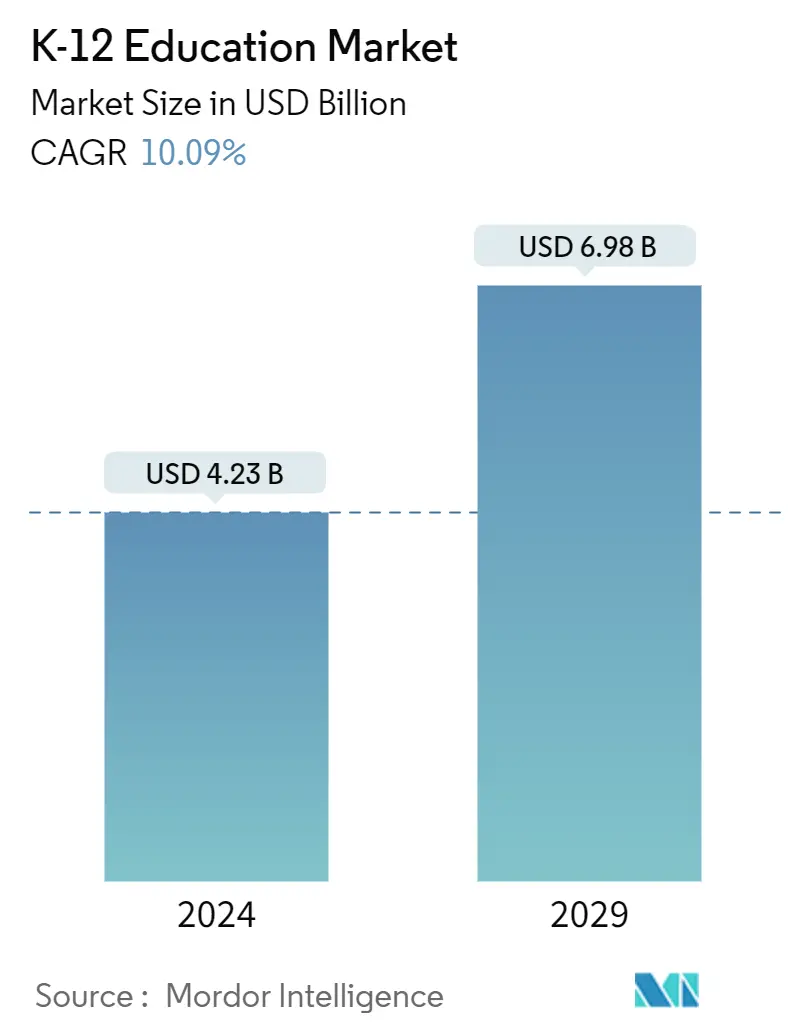Market Size of K-12 Education Industry

| Study Period | 2019-2029 |
| Market Size (2024) | USD 4.23 Billion |
| Market Size (2029) | USD 6.98 Billion |
| CAGR (2024 - 2029) | 10.09 % |
| Fastest Growing Market | Asia Pacific |
| Largest Market | Asia-Pacific |
Major Players
*Disclaimer: Major Players sorted in no particular order |
Need a report that reflects how COVID-19 has impacted this market and its growth?
K-12 Education Market Analysis
The K-12 Education Market size is estimated at USD 4.23 billion in 2024, and is expected to reach USD 6.98 billion by 2029, growing at a CAGR of 10.09% during the forecast period (2024-2029).
The K-12 education market analyzes digital learning platforms and services (e-learning and learning management services) across K-12 for students and instructors. The study tracks the demand for the K-12-based education technology market based on the contribution of platform solutions and services offered by vendors worldwide.
- The increasing popularity of online education due to its benefits, such as giving students more valuable and video-based content for a better understanding of the subjects in K-12 schools, is driving the market growth of digital learning solutions worldwide. For instance, in September 2023, Adobe, the American multinational computer software company, partnered with India's Ministry of Education to provide schools with Adobe Express-based curriculum, training, and certification. The initiative plans to cover 20 million students and 500,000 educators across India by 2027, showing the increasing adoption of software tool-based education in K-12 institutions. Such developments are expected to drive the growth of the market studied.
- The popularity of online learning has seen substantial growth during and after the COVID-19 pandemic, largely governed by the growth in a number of online learning platforms, coupled with benefits such as accessibility, flexibility, and affordability. In addition, the rise of online education in the K-12 sector has revolutionized the education sector, leading to the emergence of new online learning platforms and delivery methods. The growth in internet penetration and smartphone penetration has emerged as a driver for the growing popularity of online learning in K-12 schools.
- Online education can also provide students with more opportunities. This includes allowing them to study at an international institution without having to travel or move abroad. This method of learning is also more cost-effective because it cuts out the need for the student to travel to attend classes or, in some cases, the need to purchase textbooks.
- However, the lack of digital infrastructures, the presence of digital divides, and the unavailability of supporting internet infrastructure in many rural and sub-urban parts of the world, especially in underdeveloped and developing economies, are restricting the growth of e-learning, hampering the growth of the K-12 education market.
- The high growth and adoption of education technology during the COVID-19 pandemic, which includes the development of language apps, virtual tutoring, video conferencing tools, and online learning software to support continuous learning in the K-12 schools amidst the global lockdown and social distancing, has raised the demand for online teaching methods and fueled the market's growth. The World Bank stated that the COVID-19 pandemic disrupted education in over 150 countries and affected 1.6 billion students. Many countries implemented remote learning as an emergency response, which boosted the K-12 education market worldwide. The increasing trend of digitalization in classroom learning programs supports the market's growth.
